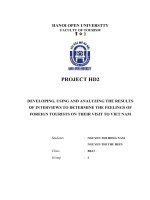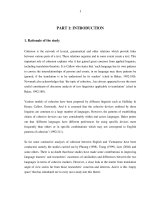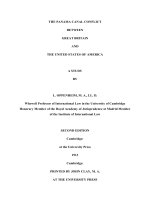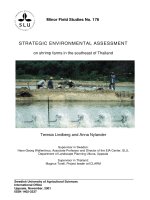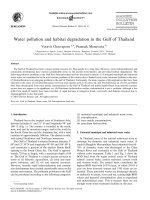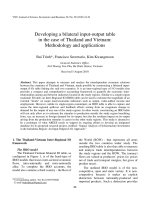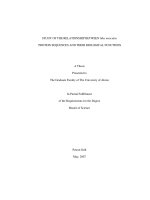Surveying the difference of TFP between group of taiwan korea and group of thailand – malaysia; and their TFP growths determinants
Bạn đang xem bản rút gọn của tài liệu. Xem và tải ngay bản đầy đủ của tài liệu tại đây (1.74 MB, 74 trang )
UNIVERSITY OF ECONOMICS
HO CHI MINH CITY VIETNAM
INSTITUTE OF SOCIAL STUDIES THE HAGUE
THE NETHERLANDS
VIETNAM - NETHERLANDS
PROGRAMME FOR M.A IN DEVELOPMENT ECONOMICS
SURVEYING THE DIFFERENCE OF TFP BETWEEN
GROUP OF TAIWAN - KOREA AND
GROUP OF THAILAND – MALAYSIA;
AND THEIR TFP’S DETERMINANTS
BY
DUONG KHANH TOAN
MASTER OF ARTS IN DEVELOPMENT ECONOMICS
HCHIMINH CITY, DECEMBER 2013
i
UNIVERSITY OF ECONOMICS
HO CHI MINH CITY VIETNAM
INSTITUTE OF SOCIAL STUDIES THE HAGUE
THE NETHERLANDS
VIETNAM - NETHERLANDS
PROGRAMME FOR MA IN DEVELOPMENT ECONOMICS
SURVEYING THE DIFFERENCE OF TFP BETWEEN
GROUP OF TAIWAN - KOREA AND
GROUP OF THAILAND – MALAYSIA;
AND THEIR TFP’S DETERMINANTS
A thesis submitted in partial fulfilment of the requirements for the degree of
MASTER OF ARTS IN DEVELOPMENT ECONOMICS
BY
DUONG KHANH TOAN
Academic Supervisor:
Dr. TRUONG DANG THUY
HOCHIMINH CITY, DECEMBER 2013
ii
iii
TABLE OF CONTENTS
Abstract .......................................................................................................................................... vi
CERTIFICATION ........................................................................................................................ vii
ACKNOWLEDGMENTS ........................................................................................................... viii
LIST OF TABLES ......................................................................................................................... ix
LIST OF FIGURES ....................................................................................................................... ix
ABBREVIATIONS ........................................................................................................................ x
Chapter I.......................................................................................................................................... 1
1.1.
Problem statement: ........................................................................................................ 1
1.2.
Research objectives: ....................................................................................................... 3
1.3.
Research questions: ........................................................................................................ 4
1.4.
Research hypothesis: ...................................................................................................... 4
1.5.
Study scope and data ..................................................................................................... 4
Chapter 2 ......................................................................................................................................... 5
2.1.
Middle income trap and the link with TFP: ................................................................ 5
2.2.
TFP and Determinants to TFP level ............................................................................. 6
2.2.1.
TFP ........................................................................................................................... 6
2.2.2.
TFP growth’s determinants: ................................................................................ 10
2.3.
Empirical review: ......................................................................................................... 12
2.4.
Analytical Framework ................................................................................................. 19
Chapter III ..................................................................................................................................... 20
3.1. Data source and data process ............................................................................................. 20
3.2. Methodology ...................................................................................................................... 22
3.2.1. TFP calculation following growth accounting approach ............................................ 22
3.2.2. TFP calculation following regression approach ......................................................... 23
3.3. TFP’s determinant .............................................................................................................. 26
3.3.1. Determinants’ definition: ............................................................................................ 26
3.3.2. Model specification:.................................................................................................... 27
Chapter IV ..................................................................................................................................... 29
4.1. TFP computing................................................................................................................... 29
4.1.1. TFP level model and value ......................................................................................... 29
4.1.2. The contribution of TFP growth to national output growth ........................................ 31
4.2. TFP’s determinant – Emperical result ............................................................................... 34
Chapter V ...................................................................................................................................... 36
iv
5.1. Conclusion ......................................................................................................................... 36
5.2. Policy implication .............................................................................................................. 37
5.3. Limitation and further research .......................................................................................... 38
REFERENCES ............................................................................................................................. 40
APPENDIX ................................................................................................................................... 44
APPENDIX 1 ............................................................................................................................ 44
APPENDIX 2 ............................................................................................................................ 44
APPENDIX 3 ............................................................................................................................ 45
APPENDIX 4 ............................................................................................................................ 47
APPENDIX 5 ............................................................................................................................ 48
v
Abstract
This study via econometric regression to calculate TFP level, and TFPG’s contribution to
aggregate output growth rate of group [Taiwan – Korea] who have successfully shifted
up to high-come level and group [Thailand – Malaysia] who have still stuck in middle
income trap. This paper also estimates how much efficiency of determinants which are
education, openness, foreign direct investment, R&D result, and economy’s fluctuation
effecting on the TFP level of these countries. The results from the paper would contribute
some implies to such Vietnam economic growth in term of handling experiments to rise
up from middle income level after escaping from poverty trap.
vi
CERTIFICATION
“I hereby certify that this thesis has not already been submitted for any degree and have
not been currently submitted for any other degree.
I certify that to the best of my knowledge and helps received in preparing this thesis and
all sources used have been acknowledged in this thesis. ”
Duong Khanh Toan
vii
ACKNOWLEDGMENTS
“The thesis at VNP is a painful process” I would like to begin my acknowledgment with the
quoting from an email of Doctor Truong Dang Thuy as it is really true to my case. This would be
not a while paint but a going with life if I cannot achieve and reach the end of what I have
dreamed, targeted and pursued. Without your support, encouragement, and pressing even, I was
totally fell on the road.
I would like to send the most gratefulness to my big family with all members who always stand
by me at the harshest time. Those are my dad, my sisters, my wife and my two lovely angles,
especially my passed away mom. Her love is with me forever, that always refill my energy all
the time I fell mostly exhausted.
I am deeply indebted to Doctor Truong Dang Thuy, Lecturer at Faculty of Development
Economics, University of Economics, Hochiminh City. He has not only been willing to pick me
up but also gave me substantial guidance, useful tips, and encouraged me to pursue to the end of
this challenge. His wholehearted discussions, and revise with patience have enabled me to
achieve, enrich knowledge and experiment through the thesis.
Equally, I wish to express my thankfulness to Professor Doctor Nguyen Trong Hoai, Lecturer at
Faculty of Development Economics, Vice Rector of University of Economics, Hochiminh City.
He was the first one who gave me support and significant advices as starting point of concept
notes. Also, without his favor granting, permission, and willing care I would be not able to
continue the race.
I also take this chance to bring my sincere thanks to Doctor Pham Khanh Nam, Master Quan
Minh Quoc Binh, Master Le Hoang Viet Phuong for right time tips and instruction to keep my
study on track.
Finally, it is my special thanks sending to Mr. Nguyen Dinh Quy (Program Librarian) and Ms.
Tang Thi Xuan Hong (Programme Secretary) for their warming helps during the time.
Duong Khanh Toan
Hochiminh city, December 2013
viii
LIST OF TABLES
Table 1.1.
Table 2.3.
Table 4.1.1 (a)
Table 4.1.2 (a)
Table 4.1.2 (b):
Table 4.2
Economic indicators of four
countries
Empirical review
Page 2
Page 12- 18
Summary about regression
result
Page 29 – 30
Regressed result for model
(6) & (7)
Ranking of TFPG’s
contribution to aggregate
output growth
Page 31
Result of regression model
of TFP level’s determinants
Page 31
Page 34
LIST OF FIGURES
Figure 4.1.2 a.
Figure 4.1.2 b
The trend of TFPG’s
contribution to aggregate
output growth
. GDP and GDP per capita
from 1962 – 2010
Page 32
Page 33
ix
ABBREVIATIONS
FDI
Foreign Direct Investment
FEM
Fixed Effect Model
IMF
International Monetary Fund
GLS
Generalized Least Square
OLS
Ordinary Least Square
REM
Random Effect Model
R&D
Research and Development
TFP
Total Factor Productivity
TFPG
Total Factor Productivity Growth
x
Chapter I
INTRODUCTION
1.1.
Problem statement:
High income trap is a concept which was initially referred by World Bank economists
Homi Kharas, and Indermit Gill in 2007 in the book named An East Asian Renaissance,
Ideas for Economic Growth. Although this concept is still controversial among
economists its phenomenon in terms of statistic aspect is very clear.
Abramovitz (1986) argued that the backward countries would have advantages to catch
up the richer ones, and GDP per capita would be convergence among the countries. Yet
the reality shows another picture. As Jesus Felipe (2012), in 1980 there were 47 countries
in group of low income; but in 2001 the number of low income members was 48; and
there were only 8 ones have left the low-income group for promoting to higher level
since then while there were some unfortunate countries felt back after few years of
shifting up. The optimism in the transition from middle income class to high income class
is much less. In 2010, 52 countries were classified as middle income countries of which
14 in upper level and the remaining in the lower level, that was not much different from
the situation in 1980 of 56 countries including 46 members in lower, and 10 in higher
level, Jesus Felipe (2012). The successful up-shifters are just South Korea, Taiwan,
Slovakia, Slovenia, Czech Republic as referred in Alejandro Foxley and Fernando
Sossdorf (2011). All means that the countries which can pass over the threshold to the
upper level are rather few. Jesus Felipe (2012) pointed out the countries which achieved
average growth rate of 3.5% per annum at least can escape from higher middle income
trap for 14 years. According to his statistic description method, a country which can
remain a plausible growth rate would have chance to move up to higher income group,
that led him come out the natured question about the source of growth finally.
This paper try to analyze the source of growth of the four countries of which the two
nations Korea and Taiwan are the ones successfully shifting up to advanced economies;
1
and the two remaining are in upper middle income group1, in terms of supply side aspect
specializing in TFP level, and its determinants. This would be likely some referral
experience to Vietnam (the country who has some common to the four mentioned in
different aspects) in upcoming time when it converges to upper middle income fraction.
Firstly let go to see the hereunder table, GDP per capita is calculated under international
GK dollar with 2005 constant price, and the average growth rate of GDP of Korea,
Taiwan, Thailand, and Malaysia during 1962 and 2010.
Table 1.1. Economic indicators of four countries
No.
Item
in year
Korea
44,559,174
Taiwan
23,905,699
GDP
1962
1 (‘,000)
GDP in year 2010 1,294,389,181 739,508,758
2 (‘,000)
Average growth rate of
7.22%
7.32%
GDP during 1962 –
3 2010 (%) (*)
1,686.55
2,005.69
4 GDP per capita in 1962
26,613.77
32,117.70
5 GDP per capita in 2010
Average growth rate of
6.01%
6.00%
GDP per capita during
6 1962 – 2010 (%) (*)
Average growth rate of
1.28%
1.38%
Population during 1962
7 – 2010 (%) (*)
Source: Extracted from PWT 7.1 and author’s calculation2
Malaysia
14,035,402
Thailand
29,944,652
338,208,183
535,039,749
6.82%
6.15%
1,575.88
11,961.50
4.43%
1,023.28
8,065.57
4.47%
2.44%
1.72%
Surveying the table at the item of GDP we can see Korea is the biggest scale and the
smallest one is Malaysia. Both Korean and Taiwan have the higher GDP’s average
growth rate in compare with Thailand and Malaysia while the latter have the higher
population growth rates.
1
As Jesus Felipe (2012), Malaysia is the country which trapped while Thailand is not. However, in relative with the
speeding of Korea, and Taiwan for transitioning to high income group, Thailand could be called in trapped
somehow.
2
Author of PTW 7.1 applied PPP Converted system at year 2005 constant prices for GDP, and GDP per capita
2
GDP per capita at the starting point also shows the departure level of Taiwan and Korea
is bigger than the rest ones. Those consequently give the advantage of the growth rate of
GDP per capita to Taiwan and Korea for taking off in the while. All the things seemed to
be that it is hard to say anything about the reason why Taiwan, and Korea can shift up the
advanced economy sooner than Malaysia, and Thailand. However, it would be interesting
if we know that excepting Thailand became lower middle income in 1976, Taiwan joined
in lower middle income group in 1967, and only two years later both Malaysia and Korea
also participated in 1969. But everything goes significantly different thereafter. Korea
and Taiwan need 19 years to move up to upper middle income while Thailand and
Malaysia get stuck with the group for 28 years, and 27 years respectively. The moving-up
speed of Korea and Taiwan is accelerated with only 7 years for transmitted to high
income countries that left Malaysia, and Thailand far away in upper middle income being
of 16 year, and 8 years respectively3 Jesus Filipe (2012).
That situation proved that there should be something should be analyzed and made clear
about the sources of these countries’ growth in terms of supply side. We will check these
countries with the same models derived from Cobb Douglas function and go in deep of
TFP breakdown. For calculating and contemplating TFP level I used the period from
1962 to 2010 because it is the duration plausible enough when the four countries started
industrialization under the export-led orientation replacing the import substitution
instead, yet with different level of departure.
1.2.
Research objectives:
(1) Examining the sources of the countries’ growth in terms of total factor
productivity and one of its part i.e Technology.
(2) Calculating and contemplating the moving of the TFP, and its part: Technology as
other factors to capital (K) and labor (L) of each group by time period from 1962 –
2010.
(3) Regressing TFP’s determinants to estimate their efficiency besides K, and L.
(4) Policy implication to Vietnam economic development path in coming time.
3
Calculating until to 2012
3
1.3.
Research questions:
The study would answer the following questions:
(1) What is the difference in movement of TFP’s contribution of these countries? And
how much the difference is? Is there any abnormal shift of TFP lines of Korea and
Taiwan in relative with Thailand and Malaysia or it is just about time to catch up?
(2) What are the determinants should be counted to TFP’s level? And how much
significance of each determinant on TFP’s level?
1.4.
Research hypothesis:
Hypotheses 1: It is existed the shift of TFP of Taiwan and Korea by time while
the TFP of Thailand and Malaysia moves gently indicating the divergence
between the lines.
Hypotheses 2: Openness is significant to TFP of which larger effect to the Korea
and Taiwan case.
Hypotheses 3: FDI is significant to TFP of which larger positive effect to Korea
and Taiwan
Hypotheses 4: Education would significantly effect on TFP
Hypotheses 5: Patent as a positive result of countries’ R&D activities would be
also significant effect on TFP.
Hypotheses 6: CPI would significantly negative effect on TFP.
1.5.
Study scope and data
Main methods which are used in this research are GLS and FEM regression. Data
combined from sources of The Conference Board Total Economy Data BaseTM,
PWT, UNDP, Barro and Lee, IMF, and UNTAD. Software STATA is used for
deploying data and processed the sample from the period of 1962 – 2010 for the four
countries. However, due to the availability of data that I expoilted, the data of GDP
(Y), Capital stock (K), and labor force (L) is used to applied econometric regression
to calculate TFP level, and the contribution of its growth rate to the economic
growth rate would be from 1962 to 2010 while the dataset of TFP’s determinants
could be only collected from 1980 – 2010.
4
Chapter 2
LITERATURE REVIEW
2.1.
Middle income trap and the link with TFP:
Middle income trap is just a toddler definition that still be debated around the world.
This so-call name has been referred by World Bank’s economists Indermit Gill, Homi
Kharas, et al. (2007) and supported by some other such as Kenichi Ohno (2009,
2010), Alejandro Foxley and Fernando Sossdorf (2011), Jesus Felipe (2012), Anna
Jankowska, Arne J.Nagengast and Jose Ramon Perea (2012). The definition creates
many supporting or against ideas mainly occurred in Asia and South America because
there are a lot of countries of the regions are referred trapped or so-called name.
Although the definition is under discussed, everyone has observed the real
phenomenon that there are significantly different between the countries who have
successfully moved up to high-income economy like Taiwan, Korea, or some their
regional hood precedents like Japan, Hongkong, or Singapore and the country like
Malaysia in terms of the duration of being in the upper middle income group.
There are quite many empirical studies concerning to analyzing these successful
countries like Taiwan and Korea in terms of source of growth but there are few to
survey the differences between the above mentioned and the middle income retainers
(i.e. the connecting with middle income trap). The analysis methods mostly are used
in the latter papers are statistic description, qualitative, combined with case study. The
updated method has been used is Product space map deployed from the paper of
Hidalgo et al., (2007) of Anna Jankowska, Arne J.Nagengast, and Jose Ramon Perea
(2012) in which the authors provided a comparing two maps of all traded goods
presenting proximity or similarity among commodities, that of between an
overcoming country, and a trapped country, in order to show the difference between
the countries’ structure transformation. This method is one of useful analytical tool to
deepen one major factor effecting on the successful escaping from middle income trap
of Korea, and Taiwan. Keninchi Ohno referred in his papers many qualitative
variables like policy makers’ wise, business momentums, national spirit, ethnic’s
5
nature or difficult to quantified like the renovation to working-hardness4 or privatesector dynamic.
While Jesus Felipe (2012) mined statistic description of 125
countries in a hundred years to supply threshold standards to the middle income
remaining ones based on the experiences of successful predecessors, Alejandro
Foxley and Fernando Sossdorf (2011) combined the similar method with case studies
to withdrawn the differences among. These papers anyway go to the same issue
concerning to the role of TFP as the shift parameter as the neoclassical theory’s
assumption of diminishing return of the inputs.
Albeit there have been an immense ocean of paper discussing about TFP and the
source of growth originated from exogenous model of Solow (1957) to endogenous
model of Romer (1986) and their later followers, papers embodied the direct
connection between TFP, middle income trap, and TFP’s decomposition are quite few
relatively. However, the accumulation of papers about source of growth has
contributed good enough to serve in the study. The two recent good works concerning
to the topic are Aiyar, Duval, Puy, Wu, Zhang (2013), and Daude, Arias (2010).
Among the outcomes in their paper, Christian Daude and Eduardo Fernandes Arias
pointed out that the gap of income between typical country in Latin American and
U.S was determined by the gap of TFP. The IMF’s economist 5 whilst go deeper with
the determinants of growth slowdown of which TFP contributed quite large
proportion.
2.2.
TFP and Determinants to TFP level
2.2.1. TFP
The debate about TFP and TFP growth concept and measurement has been lasting for
decades when its about mentioned was introduced by Solows (1957) and an
independent work of Abramovitz (1956), though its role to the growth is supported 6
by a large amount of papers prevailing over the opposite ideas of Kim and Lau (1993)
4
Using some variables presenting for human capital that are commonly in empirical papers could lead the readers to
misunderstanding. Besides, the long-term survey for hundred years would be also obstacle.
5
It is referred to Shekhar Aiyar, Romain Duval, Damien Puy, Yiqun Wu, Longmei Zhang
6
Chen (2002) has concluded that TFP played a plausible important role to the growth of the Asian growth especially
the East Asian Miracle.
6
or Kumar and Russell (2002) as remark of Aiyar et als (2013). There is no large
academic consensus literature or theory about TFP, TFP growth, as well as its
measurement, that lead to a vast of methods to estimate. They are not independent but
derived from the growth theory in term of what is the dynamic to shift a country’s
output to higher level in the circumstance of diminishing return effect on individual
inputs. Various arguments about TFP are still developing with many branches thanks
to economists’ ambition to find out resource of economic growth. However, base on
their root from which they departed we can categorized the TFP’s literature into two
paths which are exogenous model pioneered by Solow (1956), Swan (1956) and from
which related endogenous model led by Arrow (1962), Lucas (1988), Romer (1990),
Aghion and Howitt (1992). Both such kind models are though different in perception
to TFP whether as the intrinsic improvement or an externality yet admit the role of
TFP as source of growth.
2.2.1.1.
Endogenous model
Different from neoclassical model as assuming general production function Y = F (At,
Kt, Lt) whose growth is attributable to Kt, Lt, and At, and they are independent. This
enables the treatment to At as exogeneity factor to Kt and Lt that can help level up the
output. Yet in his works in 1962, Arrow has argued that At has been improved during
the investment process in terms of capital and labor. As more working by
supplementing capital worker gets smarter, more efficient, grasps more new ideas,
and more innovation, that would lead to the result of At’s improvement. Such process
is called learning by doing. During the time of experience and intelligence enriched,
their diffusion is getting larger, and spreads from an economy to another and further
thanks to the moving and generation of workforce accompanied with what skill they
grasped. The model is begun with so called AK model:
Y BK L1
B (is as At) is being grown via learning by doing process that it is enriched by
supplemented capital:
B A.K 1 (A>0)
7
Such expression treats level of technology B which is effected capital accumulation as
endogenous factor to growth.
Lucas (1986) introduced concept of human capital whereby Romer (1990) developed
this into a process such called spill-over effect in his excellent paper. Romer splitted
human capital into two kinds that one is public and the other is restricted by rivalry or
excludability or both. R&D model is more specific assembled with three core bases
including (i) mutual effect between technology and capital accumulation; (ii) R&D
activities as firm’s activities encouraged by market motivation and (iii) the treatment
to these as a public goods or a non-rival excludable goods; of which base (ii) is his
distinctive argument against exogenous thinking. He argued previous papers could not
satisfy all three bases even endogenous precedent of Arrow(1962) but Schumpeter
(1942) whose concept was developed by Aghion and Howitt (1992, 2002). In R&D
modeling, production process is separated into two processes of which idea is
produced as input goods to the remaining. In general, we can describe through
following assumptions:
-
Labor is divided into LA (labor for R&D activity) and LY (labor for producing
consumption goods) that is L = LA+ LY;
-
New innovation (technology) 𝐴̇ based on past knowledge assembled in labor
working in creativity that is: 𝐴̇ = 𝛿 𝐿𝜆𝐴 with 𝛿 is the productivity (rate of
generating ideas); and 𝛿 = 𝛿𝐴𝜑 ; with λ , φ < 1
-
From the two assumptions above we can go to the function that presents the
endogeneity of innovation.
𝐴̇ = 𝛿𝐴φ 𝐿𝜆𝐴
The model implies that such countries that experienced more accumulated human
capital would generate more total factor productivity.
2.2.1.2.
Exogenous model
The kind of model began with growth accounting concept of Solow (1956), and still
has play the corner stone of neoclassical schooling about growth theory. This
8
schooling from thereon has many developments improving in explaining the shift-up
factor as erogeneity including with debate about its true value in economic growth.
Solow began his growth model with Cobb Douglas function with such inputs of
capital and labor
Yt = Af(Kt, Lt) = AKβtLαt (α, β >0)
The implication of constant return to scale that: α + β = 1 and
ΩY = Ωf(Kt, Lt) = f(ΩKt, ΩLt)
The economy produced only one goods without government and international trade
with the condition of technology A treated as constant. Under the umbrella of formula
and conditions, it could refer to the changing of marginal as input changing such like:
𝜕𝑌
= 𝛽𝐴𝐾𝛽−1 𝐿1−𝛽 > 0 (𝑖)
𝜕𝐾
𝜕𝑌
= (1 − 𝛽)𝐴𝐾𝛽 𝐿−𝛽 > 0(𝑖𝑖)
𝜕𝐿
That mean production function is an increasing function as input increase. However
when the marginal of production function regarding to each input is a decreasing
function because:
𝜕2𝑌
= (𝛽 − 1)𝛽𝐴𝐾𝛽−2 𝐿1−𝛽 < 0
𝜕𝐾 2
𝜕2𝑌
= −𝛽(1 − 𝛽)𝐴𝐾𝛽 𝐿−𝛽−1 < 0
2
𝜕𝐿
They mean that as growing of input into the production, the output is growing with
accelerating smaller increase.
The production function is rewritten under per worker form by dividing both sides of
the equation to L such like:
𝛽 𝐿 1−𝛽
𝑌
𝐾𝛽 𝐿1−𝛽
𝐾
𝑦= =𝐴
= 𝐴 (𝐿 ) ( )
= 𝐴𝑘 𝛽
𝐿
𝐿
𝐿
The equation showed that capital per worker has position effect on output per worker.
Solow added assumption to capital by the source of capital was from output’s saving
that the capital stock was measured: 𝐾̇ = 𝑠𝑌 − ∆𝐾 of which s was constant ratio
9
saving and ∆ was capital’s constant depreciation rate; and the constant growth rate of
labour is θ. After algebraic changing Solow went to the finding that growth of capital
in its turn depent on saving rate, technology (positive), population growth and
depreciation rate (negative). Connecting the two findings that we can conclude about
the source of growth thanks to technology, national saving, and population
controlling. While other factors imply policy making Solow did not explain more
about technology term but treat it as exogenous factor.
Though driven by methodology estimating TFP as residual, many economists yet
consist that TFP is not a casualty as a “manna from heaven” Chen (1993), Hulten
(2001) but the true fact happenning in the countries of which industry, technology,
and living standard are being improved in world’s nation hierarchy.
2.2.2. TFP growth’s determinants:
This part is mainly discussed about other determinants to TFP.
Human capital: This is the most particular determinant that both endogenous and
exogenous schooling focus on explaining the source of growth. Many economists
expanded Cobb Douglas function assembled with human capital under such form Y =
AKαH1- α = AKα(hL)1-α. As study of Psacharopoulos & Patrinos (2004) he estimated
human capital as the function of exponent of Number e of which the exponent is the
multiple product of return rate and the average schooling year of population from 15
to 60 years old denoted with the general form h= eφ(t). Folloni, Vittadini (2010),
Sianesi, Van Reenen (2003) found the effect of human capital on the growth is a
complicated process. Taking human capital yet account for output function is a
controversial issue Miller, Uadhyay (2000). Mankiw et als (1992) supported for this
controversy. Their arguments were that human capital rather influenced growth via
TFP than directly on output. Another thing is that human capital should be preferred
as a kind of capital than labor Miller, Uadhyay (2000) for its inter-effect on both
10
production inputs in terms of laborer efficiency improvement, and capability to grasp
the higher technology7.
Openness is vital to every country who wants to grow especially developing
countries. It is the key to import the technology from advanced economies (import), to
open the very broaden market rather than the domestic one, and to improve the owned
self capacity in terms of capital, labor productivity, and efficiency grasping as well as
deploying new technology, that proving via the world’s acceptance to its exporting
products in the value chain. Trade in terms of Export and Import could be good
proxied for Openness argued by Dollar and Kraay (2004), Nachega and Fontaine
(2006), Loko and Diouf (2009)8. ). Khan (2006), Depachitra and Dai (2012) found
openness trade has significant negative effect on TFP, that goes opposite to the
hypothesis of positive effect of trade to growth. These could be come from the multicollinear effect; or the national trade structure.
Export valued to Openness because it presents simultaneously how much integral
deepening into the world economy, the international competitiveness, and the payable
demand to its exporting product. Miller and Upadhyay (2000) found that it was better
significant if we use Export to GDP ratio solely rather the Trade turnover to GDP
(import plus export9). And we would also follow this way for our above arguments.
Another term is also relative to Openness is FDI. FDI is considered as a way of
technology spill over and management knowhow importing from high income
countries to developing countries. It should be reasonably estimated that FDI has
positive effect on TFP growth showed by most of paper about this determinant’s role.
However, there are some studies to show the opposite way like Gorg and Greenaway
(2003). The reason of against outcome could be come from the absorptive capability,
and investment environment of FDI receiver. However, it is reasonably to put it into
7
TFP should be seen as the other things from production inputs (i.e. the combination from technology progress,
technical efficiency, labor productivity, labor capability to grasp the new equipment and technology, working
conditions, etc.,). This understanding would ease the finding of some authors that TFP plays no role in growth.
8
This way is considered some certain bias if the country relied too much on trade activities of natural resources such
as oil, more minerals as Loko and Diouf (2009), Daude, Fernandez-Arias (2010).
9
Jajri (2007) follows this way.
11
the model for its unbeatable role to the growth Miller and Upadhyay (2000), Loko and
Diouf (2009), Delpachitra and Dai10 (2012), Driffield and Jones (2013).
The inflation: CPI is also good factor to show the ease of the economy condition for
development, and the macroeconomic stability. On the other hand, this is the plausible
proxy for the capability of government in macro economy management Miller and
Upadhyay (2000), Nachega and Fontaine (2006).
R&D: Endogenous schooling has pioneered mentioning about R&D effect on growth.
Empirical study of Grilliches and Mairesse (1991) on firm level, Guellec and Potterie
(2001) on national level also affirmed the role of R&D to growth. Both papers used
R&D expenditures as the proxy for this activity. However R&D is a two dimension
that it could not be able to explain in the case the research and development go to
nowhere. This made I prefer to find other proxy that could be closer to R&D’s
usefulness such as patent grant. There are many innovations and inventions which are
made and created every day. Yet people tend to protect their intelligence if they
thought that their works would be helpful to society.
2.3.
Empirical review:
Table 2.3. Empirical review
Author
Methodology
Data set/Variables
Result
Christian Daude,
Growth regression i.e. calculating Data from 76 nations There
is
Eduardo
TFP from taken logarithm Cobb- combined from source of divergence of
Fernandez-Arias
Douglas function included human PWT 6.2; WDI 2005 – GDP
(2010)
resource capital, in which factors 2008; Barro – Lee 2000. capita
per
are calculated averagely (y: income Data is set into 3 group between Latin
per capita = Y/N; k: capital per (Latin
American America
worker = K/L; h: human capital = countries - LAC; Rest of proxied
H/L = eφ(s); f: ratio between L and World: ROW; Countries country
population
10
=
L/N.
Authors whose
income
was
Delpachitra and Dai (2012) have put FDI into the model but found it is no significant.
12
developed from the above function initially,
by
1960
for the gap of the above factors and comparable to that of
outcome between the proxy country LAC
and benchmark country.
–
Asian
TWIN;
East
–
EA;
tigers
currently
developed
countries
DEV)
with
USA is deemed as the
benchmark country.
Stephen
Miller,
M. Growth
regression
for
TFP Data from 83 countries Openness
Mukti calculation; OLS with Fixed effect and six time periods trade
has
P.Upadhyay
method for parametric estimation of combined from source of significant
(2000)
TFP’s determinants.
PWT 5.6; Summer and positive effect
Heston
(1991);
Barro on TFP while
and Lee (1996); IMF human capital
(1996),
WB
(various effect on TFP
issues); United Nations specifically.
Monthly
Bulletin
of Inflation
Statistic (various issues); significantly
International
Yearbook
Financial negative
(various effect
issues); UNTAD (1994).
on
TFP.
Trade openness proxied
by export to GDP ratio;
Term of Trade; inflation
proxied by CPI; Local
price
deviation
from
purchasing power parity
(PWT 5.6)
13
Jean-Claude
Nachega
Growth
accounting
and calculation;
Thomson
supplemented
Fontaine (2006)
specific
OLS
with
method
for
for
TFP Data mined from World The departure
regression Economic Outlook; and of Niger as an
General
to International
parametric Statistic;
estimation of TFP’s determinants.
Financial agrarian
World
development
Bank country, and
Indicator natural
for the period (1967- endowment
2003);
Center
for (oil)
has
International
specified
its
Development
and economy
to
Conflict
Management, be vulnerable
University of Maryland.
to exogenous
Variables measured in shock;
terms of % of GDP: Government
openness
(import
to
plus
trade: consumption
export); has
Government
significant
Consumption; aid (ODA negative
proxied); finance (bank effect to TFP
deposits); fiscal (overall as the burden
fiscal balance).
to
growth
Other variables: Term of productivity
trade (%); rate of growth while
trade
of physical capital per openness, aid,
capita
(%);
drought finance term
(dummy); polity (index of
from
-10
inflation
to
trade
+10); significantly
positively
effect.
14
Inflation
negatively
affects but is
not
significant11.
Safdar
Ullah Growth accounting for calculating Data
Khan
Khan TFP; OLS
(2006)
is
taken
from The
Federal
Bureau
Statistic
(1998)
first
of regression
and show
that
Government of Pakistan: except
Economic
Survey population
(2004).
and education
Inflation, Openness of expenditure
Trade, FDI, Education have negative
Expenditure, and Budget effect but are
deficit, Financial Depth, not
Population
are
basic significant
variables.
others
Investment
(Domestic variables are
and
Foreign), significant at
Employment,
different
Government
level.
Consumption,
Openness
Private
Credit
is trade
additional to regression.
has
significant
negative
effect
on
TFP’s
11
The result may come from the mutual effect between Government Consumption and inflation.
15
